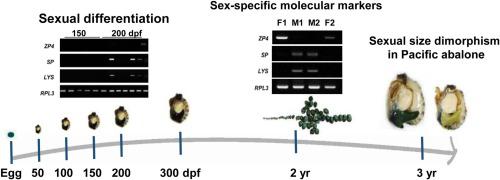Animal Reproduction Science ( IF 2.2 ) Pub Date : 2021-01-08 , DOI: 10.1016/j.anireprosci.2021.106687 Mi-Jin Choi 1 , Young Dae Oh 2 , Yeo Reum Kim 1 , Han Kyu Lim 2 , Jong-Myoung Kim 1

|
Growth rates of Pacific abalone Haliotis discus hannai are an important trait affecting the economic value in the abalone aquaculture industry. A reverse-transcription polymerase chain reaction (RT-PCR) analyses of tissues from H. discus hannai was conducted for sexually mature gonads to determine male- and female-specific target gene expression, including genes encoding zona pellucida domain 4 (zp4), sperm protein (sp) and lysin (lys), respectively. Sex-specific expression patterns of these gene expression, even in sexually immature abalone, indicate these genes can be used as sensitive and robust sex-specific molecular markers. The RT-PCR procedure was also performed to analyze tissues collected at various developmental stages (50-day intervals) beginning at fertilization to determine when sex differentiation and expression of sex-specific genes was initiated. Detection of zp4 transcript in tissues collected at 200 days post-fertilization (dpf) indicated egg-specific development starts at 150–200 dpf. To evaluate possible sex-specific differences in growth rate, there was conducting of a molecular marker-based sex identification of abalone from a population selected for rapid growth rate. In a group of large H. discus hannai, females were more prevalent than males. To assess the correlation between growth and sex, there was comparison of weights of 3-year-old Pacific abalone in specimens where there had been sex determinations by visual examination and molecular methods. The results indicated females weighed more (55.92 ± 9.38 g, n = 15) than males (43.64 ± 15.55 g, n = 6, P = 0.037), indicating females had a more rapid growth rate than males.
中文翻译:

使用编码透明带 4 的基因作为太平洋鲍鱼 Haliotis discus hannai 早期性别分化和大小二态性的雌性特异性标记
太平洋鲍鱼Haliotis discus hanai 的增长率是影响鲍鱼养殖业经济价值的重要性状。对来自H的组织进行逆转录聚合酶链反应 (RT-PCR) 分析。对性成熟的性腺进行了铁饼 hannai以确定男性和女性特异性靶基因表达,包括编码透明带结构域 4 ( zp4 )、精子蛋白 ( sp ) 和溶素 ( lys ) 的基因), 分别。这些基因表达的性别特异性表达模式,即使在性未成熟的鲍鱼中,也表明这些基因可以用作敏感和强大的性别特异性分子标记。还进行了 RT-PCR 程序以分析从受精开始的不同发育阶段(50 天间隔)收集的组织,以确定何时开始性别分化和性别特异性基因的表达。在受精后 200 天 (dpf) 收集的组织中检测zp4转录物表明卵特异性发育开始于 150-200 dpf。为了评估增长率可能存在的性别特异性差异,对选择快速增长率的鲍鱼进行了基于分子标记的性别鉴定。在一群大H中。铁饼汉奈,女性比男性更普遍。为评估生长与性别之间的相关性,比较了样本中 3 岁太平洋鲍鱼的重量,这些样本已通过视觉检查和分子方法确定性别。结果表明雌性(55.92±9.38g,n =15)比雄性(43.64±15.55g,n =6,P =0.037)重,表明雌性比雄性生长速度更快。










































 京公网安备 11010802027423号
京公网安备 11010802027423号